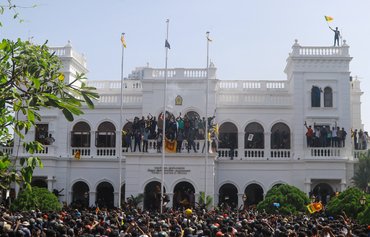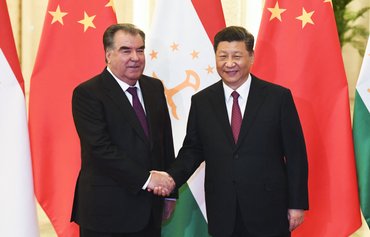MOMBASA, Kenya -- On a recent trip to Africa, Chinese Foreign Minister Wang Yi attempted to get ahead of a narrative gaining momentum around the globe as recipients of Chinese aid, loans and investment regret the long term ramifications.
Wang, speaking ahead of touring Beijing-funded infrastructure projects in Kenya, rejected suggestions that Beijing was luring African countries into debt traps by offering them massive loans.
He dismissed the idea that China's considerable lending to Africa was a strategy to extract diplomatic and commercial concessions.
"That is simply not a fact. It is speculation being played out by some with ulterior motives," he told reporters January 6 in the Kenyan port city of Mombasa.
![A view of the China-Kazakhstan Logistic Base in Lianyungang, Jiangsu province, China, last September 17. [Raul Ariano/Jiangsu Information Office]](/cnmi_di/images/2022/01/21/33680-081_afps14451-600_384.jpg)
A view of the China-Kazakhstan Logistic Base in Lianyungang, Jiangsu province, China, last September 17. [Raul Ariano/Jiangsu Information Office]
![Chinese sailors aboard the guided-missile frigate saluting a Tunisian patrol vessel after crossing out of Egypt's Suez Canal. [Chinese Ministry of Defence]](/cnmi_di/images/2022/01/21/33681-chinasuez__1_-600_384.jpg)
Chinese sailors aboard the guided-missile frigate saluting a Tunisian patrol vessel after crossing out of Egypt's Suez Canal. [Chinese Ministry of Defence]
"This is a narrative that has been created by those who do not want to see development in Africa," he said, speaking through an interpreter. "If there is any trap, it is about poverty and underdevelopment."
China is Africa's largest trading partner, with direct trade worth more than $200 billion in 2019, according to official Chinese figures.
In Kenya, China is the second-largest lender after the World Bank and has funded a number of costly infrastructure projects that have raised concerns about Nairobi taking on more debt than it can afford.
At the Port of Mombasa, China is constructing a new $353 million terminal to allow larger oil tankers to berth.
Beijing also funded Kenya's most expensive infrastructure project since independence, lending $5 billion for the construction of a railway line from Mombasa opened in 2017.
During a visit to Mombasa in January 2020, Wang described the railway as a "benchmark" of China's Belt and Road Initiative (BRI), a trillion-dollar push to improve trade links across the globe by building landmark infrastructure.
Red flags
Chinese President Xi Jinping launched the BRI in 2013 to expand China's economic and political influence, with many of the infrastructure plans seen as helping deliver its goods globally.
But among other goals, the BRI is meant to facilitate the extraction and shipping of poorer countries' natural resources for Chinese benefit.
China denies any ulterior motives to the vast investment project, but critics argue it uses the financial leverage arising from the scheme to boost its clout, in what they dub "debt-trap diplomacy" -- imposing harsh terms on loan recipients and writing contracts that allow it to seize strategic assets when debtor countries run into financial problems.
Observers have raised red flags over reliance on Chinese funding, and there is growing discontent with the terms of Chinese investment.
Aly-Khan Satchu, a Kenyan geopolitical and economic analyst, said the East African nation was at a disadvantage negotiating deals and often was stuck with high-interest repayments.
"These investments are not going to make a return on investments for the foreseeable future," he told AFP.
"You have taken out these loans, and they are making losses every month. You are essentially increasing the problems."
Examples of such predatory lending abound.
Cash-strapped Sri Lanka, for one, is already saddled with $35 billion in foreign debt -- about 10% of which belongs to China -- but rather than seek an International Monetary Fund (IMF) bailout, officials turned again to Beijing.
President Gotabaya Rajapaksa "pointed out that it would be a great relief if debt payments could be rescheduled in view of the economic crisis following the pandemic", his office said in a statement January 9.
That request was met with silence from Beijing.
Meanwhile, Central Bank governor Ajith Nivard Cabraal said talks with China over a new loan were at an "advanced stage", and a fresh agreement would service existing debt to Beijing.
"They would assist us in making the repayments... the new loan coming from China is in order to cushion our debt repayments to China itself," he said.
Sri Lanka has borrowed heavily from China for infrastructure in the past, some of which ended up as white elephants.
Unable to repay a $1.4 billion loan for a port construction in the south, Sri Lanka was forced to lease out the facility to a Chinese company for 99 years in 2017.
The United States and India have warned that the Hambantota port, located along vital east-west international shipping routes, could give China a military toehold in the Indian Ocean.
'Maritime Silk Road'
As part of the BRI, China already has constructed a series of ports along the Indian Ocean, creating a necklace of refuelling and resupply stations from the South China Sea to the Suez Canal.
One major port along this "maritime Silk Road" is in Gwadar, Pakistan, but Beijing's disregard for local workers and the environment has soured the deal.
Gwadar is expected to be a major part of the BRI, but the scale of the project -- and the debt that the Pakistani government has incurred by borrowing from Beijing to fund multi-billion-dollar infrastructure projects -- has put it in a vulnerable position.
Concern is also growing over Chinese activity at the United Arab Emirates (UAE) port of Khalifa, where intelligence officials say China was secretly building a military facility.
A closer look at the BRI reveals Beijing's aim of monopolising natural resources and expanding military ambitions from China to the Mediterranean, including locations in the Middle East, Central Asia and Africa.
To that end, China has invested heavily in Egypt in recent years -- more than $7 billion -- but analysts warn that this level of Chinese involvement in key locations and economic sectors may have dire long-term consequences.
Of particular concern are the massive investments China is pursuing in the Suez Canal economic zone.
Furthermore, Beijing's ill treatment of Muslims in Xinjiang -- including accusations of genocide, torture, sexual violence, forced labour and arbitrary detention -- has aroused anti-China sentiment.
Iraqis are too questioning the value of Chinese economic investment.
For example, a 20-year Iraqi-Chinese agreement forged in September 2019 has yet to be implemented.
The agreement is based on the idea that China would provide a $10 billion loan that would be repaid incrementally from the revenue obtained from selling Iraqi oil to China. The loan would finance major infrastructure projects in Iraq.
Those who object to the agreement say it would mortgage off Iraqi oil to China for a long period of time and would leave Iraq in China's debt.
Others fear that closer ties with China would merely serve the Iranian regime, which seeks to boost its own interests at the expense of the Iraqi economy.
Piling on debt
Several countries in Central Asia have found themselves in similar straits.
China has invested billions in the development of Turkmenistan's gas industry, establishing itself as the country's number one destination for exports.
Beijing's key projects in the country are the Central Asia-China pipeline, which begins in eastern Turkmenistan and reaches China via Uzbekistan and Kazakhstan, and a multi-stage development project at Galkynysh, the world's second-largest gas field.
During a visit to the country in 2011, China Development Bank (CDB)'s then-president, Jiang Chaoliang, said that the bank had lent Turkmenistan $8.1 billion for the projects.
Last June, the Turkmen government and CDB announced that the loans had been repaid in full, but with the terms of Chinese loans shrouded in secrecy, officials made no reference to the amount that Turkmenistan repaid or when.
Without more information, it is impossible to know exactly how Turkmenistan repaid its debts to China.
One possibility, analysts say, is that Turkmenistan is not receiving earnings from its record exports to China. Rather, the sale of gas goes toward paying off multi-billion-dollar debts owed to Beijing.
Chinese debt bondage is also a genuine threat for Kyrgyzstan, analysts say.
As of last March, Kyrgyzstan's foreign debt was $5 billion, with the largest share of it -- more than 40% -- belonging to China Eximbank, according to the Ministry of Finance.
In 2020, citing economic hardships stemming from the coronavirus pandemic, the Kyrgyz government repeatedly asked Chinese authorities to ease the terms of the loans -- at least to extend payment deadlines.
Beijing ignored the requests for almost a year, agreeing finally in November 2020 to break the 2020 payment up over the next four years. But in return for this "concession", it tacked on a fee amounting to 2% of the loan.
In crisis-hit Afghanistan, observers have tied China's increasing "assistance" since the fall of the previous government as an attempt to make the fragile country economically and politically dependent on Beijing so that it can exploit the nation's estimated $1 trillion worth mineral reserves.

![Chinese President Xi Jinping (on the screen) delivers his speech during the China-Africa Co-operation (FOCAC) meeting in Dakar, Senegal, last November 29. [Seyllou/AFP]](/cnmi_di/images/2022/01/21/33679-000_9tl6ze-600_384.jpg)






